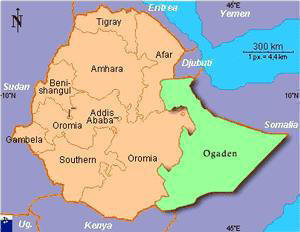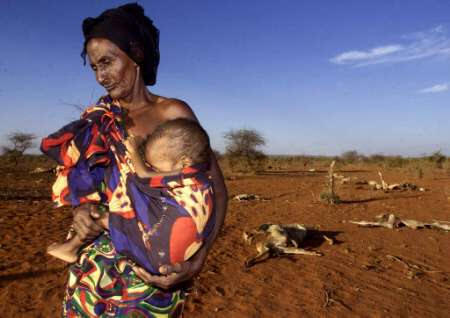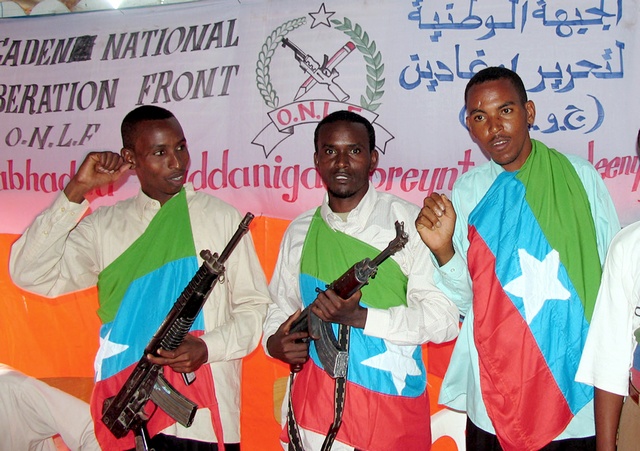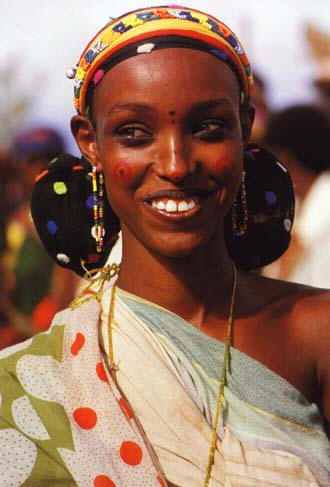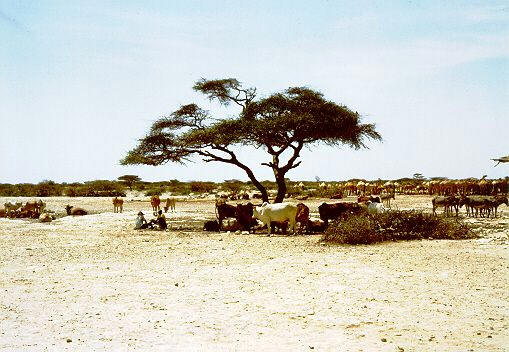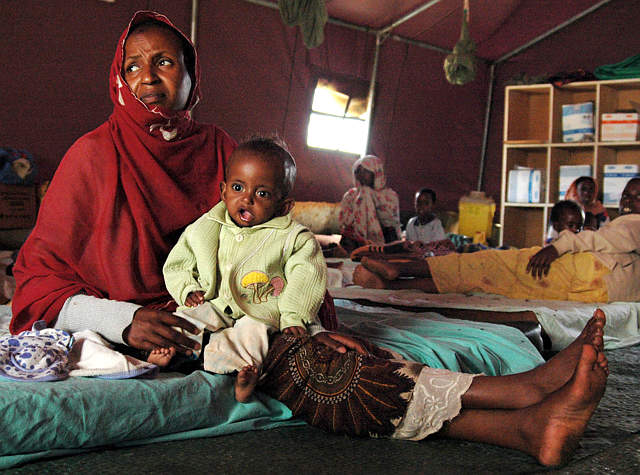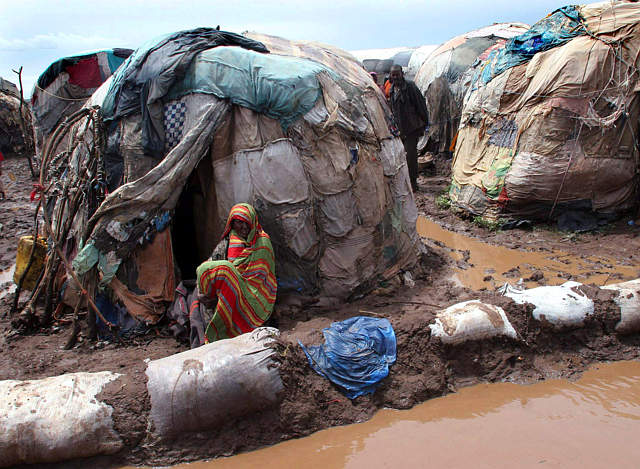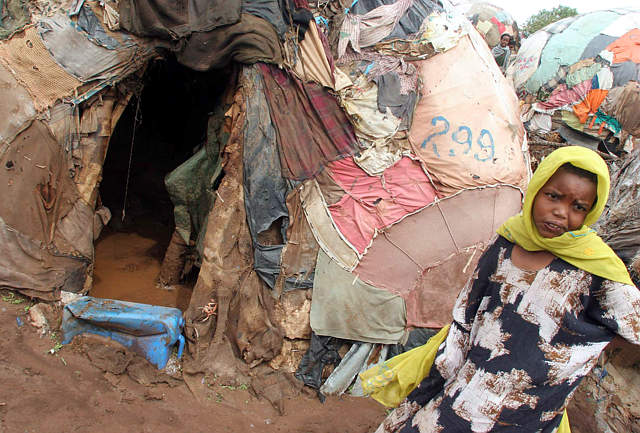| Zooming in Ogaden |
|
OGADEN IN CRISIS
OCTEBER 2006
Militiamen of Ogadenian National Liberation Front (ONLF) hold guns during the 22nd anniversary of the ONLF's founding in Somalia's capital Mogadishu, August 15, 2006. The ONLF militiamen are the members of the Union of Islamic Courts, opposing Ethiopia's military intervention in Somalia and the Ogadenian region, west of Somalia, which is under the control of Ethiopia.
Ogaden draws in tension once more
By Mohammed Adow BBC Focus On Africa magazine
October 02, 2006
The Somali region of Ethiopia, known as Ogaden by most people of Somali origin, is once again at the centre of international tension.
It is at the heart of a dispute between the Ethiopian government and Somalia's Islamic rulers.
It has left 56-year-old Mohammed Ali Hassan, like many other pastoralist nomads who live there, exhausted. He says his life is now "drought, war and darkness".
"We would like a life we can predict, without conflict, so we can give our children what has existed only in our dreams - peace and tranquillity."
Unfinished business
The region's recent history is clouded by conflict. Ceded to Ethiopia by the British in 1954, it has twice since been fought over by Ethiopia and Somalia, which - under the government of Siad Barre - claimed Ogaden was part of Greater Somalia.
For the past 20 years, the Ogaden National Liberation Front (ONLF) has waged a rebellion, fighting for independence from Ethiopia.
There has been heightened military activity this year, with tens of thousands of Ethiopian troops sent in to fight the rebels, but also to secure the border and counter what is perceived as a threat by the Union of Islamic Courts (UIC) in Somalia.
Having backed the formation of the transitional government in Somalia, with its close ally Abdullahi Yusuf as president, Ethiopia has been alarmed by the rise of the Islamic courts and their militia.
And the UIC's de facto leader, Sheikh Hassan Dahir Aweys, has made it clear that the two countries have unfinished business.
"The land taken by Ethiopia cannot be forgotten because it is attached to our blood and nationalists," he said in July, referring to troops and civilians who died during the 1977/78 war.
"Ethiopia mistreats the Somalis under their administration. The land was given to them by colonialists and we will seek justice to resolve the crisis that is dividing the two countries."
Sheikh Aweys added, however, that he was ready to negotiate with Ethiopia on the status of the contested Ogaden region.
And the last thing Ethiopia wants is trouble along its long border with Somalia.
Enemy to the north
Still nervous about internal dissent following last year's post-election violence, it is wary about unrest being stoked up among its ethnic Somalis.
Ethiopia is alleged to have responded by sending troops to protect Somalia's interim government in Baidoa and issued warnings of dire consequences for the Islamists if they attacked the town.
But reports that Eritrea, Ethiopia's enemy to the north, had been arming the Islamist militia has led analysts to warn in turn that instability in Somalia could lead to a wider regional conflict.
All this is no comfort to the people who live in the Somali region of Ethiopia. Their main concern is the lack of development - and they joke about their plight, saying that "if Adam returns he will definitely recognise our land".
The regional capital, Jijiga, is a jumble of villages with a few pompous administrative buildings, shabby hotels and bars, a busy market and a military station - all stuck together by countless mud houses with corrugated-iron roofs.
Many people who fled the hinterland and the battlefields have sought refuge there.Military jeeps share the streets with squeaky horse-drawn carts that act as taxis.
During the rainy season entire districts and provinces in the region can be cut off from one another for weeks.
Educational opportunities are also extremely limited. Informal estimates suggest that roughly 15% of youth attend secular schools. More attend the Islamic Koranic schools.
A dearth of skilled manpower, inadequate infrastructure and acute shortage of communication facilities constitute formidable constraints to developing the region.
The regional administration is weak and has struggled at times to gain legitimacy among residents and to implement effective policies.
Cultural links
In the afternoons, Jijiga becomes a ghost town, abandoned to the camels and cats.Locals are firmly ensconced behind closed doors in the sacred confines of the Mabraz, the khat den.
Here a minimum of five hours is spent reclining on cushions, smoking cigarettes and sipping tea while grazing on the leaves. After the drug takes its effect, lively debates and heated discussions break out, and the Mabraz becomes, perhaps, the region's real parliament.
From their conversations, it is clear that most Ethiopian Somalis feel culturally and socially closer to their kin in Somalia and northern Kenya than they do to the Ethiopian highlanders.
Trade with Somalia is also much greater than trade with the rest of Ethiopia. The Somali shilling is the main currency in some areas in the region.
But residents like Ali Hassan of Degeh Bur town sees no end in sight to the conflict in the region.
"We have been fighting for secession for close to 50 years now," he says.
"I think it will take another 50 years of armed struggle for us to get recognition as a state or to be accepted as Ethiopians."
Note: The people living in Ogaden are mostly nomadic; Ogaden suffered badly in 2000 following drought; The Ogaden National Liberation Front says independence is key to peace.
© BBC News Limited 2006.
Somalia for the Somalis: An idea in peril
Harun Hassan: COMMENT Aug 15, 2006 Mail & Guardian Online
During the past 15 years of war and civil conflict in Somalia, most observers -- Somalis and foreigners alike -- have understood that a resolution to the country’s problems could only come from agreement among Somalis themselves.
This has now changed in a way that carries potential dangers.
It was all very different only two months ago. In June, the political situation in Somalia seemed to offer grounds for cautious optimism. The Union of Islamic Courts (UIC), backed by considerable popular support, was banishing the warlords and their militias from large swathes of the country (including the capital, Mogadishu). After years of anarchy and chaos, the courts ostensibly presented a model of governance based on a moderate interpretation of sharia law, one that a people hungry for security and order might readily embrace.
Meanwhile, the weak Somali interim government based in the town of Baidoa -- a coalition of forces that had emerged from the peace agreement painstakingly negotiated during two years of difficult consultations in Kenya -- was obliged to acknowledge the rising power of the courts by appearing ready to engage in dialogue with the new movement.
It appeared for a moment that a combination of the force of arms, backing from war-weary Somalis and understanding of the country’s needs might make such a dialogue the foundation of a longed-for political settlement. Instead, two centres of power have been consolidated in Mogadishu and Baidoa, each with a different ideological orientation, and each claiming primary legitimacy as the authentic voice of Somalis.
More recently, a new element has been added to the mix with the active involvement of two of Somalia’s neighbours in its domestic turmoil, each seeking to strengthen one of the emerging sides: Ethiopia (Somalia’s great historic rival) in support of the formal government in Baidoa, and Eritrea (with which Ethiopia has fought two bitter wars in the last generation) in support of the Islamic courts.
This strategic rivalry over Somalia was first apparent in the reported incursion into the country by Ethiopian troops to support the interim government. Ethiopia has not officially admitted sending troops into Somalia, but both the United Nations and independent journalists have confirmed their presence in the government’s temporary base in Baidoa, and in another of its strongholds, Wajid. Ethiopia has in any case declared its intention to support the Somali government militarily and politically and to help crush the advancing Islamic courts movement.
The response of the Islamic courts has been equally blunt: it has urged a “holy war” against Ethiopia and the courts have mobilised their militias to that end. At one anti-Ethiopia rally in Mogadishu, the leader of the UIC, Sheik Sharif Sheik Ahmed said that Ethiopia’s intervention was a violation of Somalia’s sovereignty and should be steadfastly opposed.
But the UIC has its own foreign backer, evident in two secret landings at Mogadishu airport by a plane with unspecified cargo believed to be weapons. The source has not been definitively confirmed, but all indications point to Eritrea.
The United States shares the view of the Baidoa government that Eritrea is indeed involved in the internal Somali conflict. The US’s assistant secretary for African affairs, Jendayi Frazer, warned both Ethiopia and Eritrea that they should stay out of the crisis. But in saying that the international community must help the interim government stand on its feet, Frazer was also making it clear where the US government’s sympathies lie.
The logic of these foreign interventions is that the Somali crisis is no longer going to be left to the Somalis.
The presence of the Ethiopians is a factor in delaying the start of proposed talks between the Islamic courts and the government. The UIC leaders say they will not discuss matters with the government as long as foreign troops remain on Somali soil; and the Somali Parliament (also based in Baidoa) is equally opposed to any Ethiopian presence.
The UIC statement has a wider relevance than to the Ethiopian issue. An initiative by the African Union’s (AU’s) regional inter- governmental authority on development (Igad) -- which includes Ethiopia, Eritrea and Somalia among its members -- is also on the table; if implemented, this would see peacekeepers from other parts of the continent enter Somalia.
The proposal is still at an early stage: the AU has yet to approve its timescale, its mandate, and the number of troops to be sent. In order for it to proceed, the AU first wants the UN to lift an arms embargo on Somalia. Meanwhile, it now seems that two of the AU’s member-states have already violated the embargo by taking matters into their own hands.
The reported unilateral involvement of Eritrea and Ethiopia represents a potent challenge to the AU. In any case, there are three obstacles to the AU proposal.
First, two Igad members (Eritrea and Djibouti) are against it, and two others (Sudan and Uganda) say they will send troops only if all sides in Somalia agree to the deployment and announce a ceasefire. Once more, this places Ethiopia in the eye of the storm: if it declares willingness to contribute to an AU force, it may divide the region’s states as it has already reinforced internal schisms within Somalia.
Second, the Somali Contact Group recently formed by the United States (comprising the US, Britain, Norway, Tanzania, Sweden and Italy) advises against sending troops into Somalia.
Third, the proposal was made when the situation on the ground was very different. At the time, the Islamic courts -- which vigorously oppose the AU idea -- had virtually no control over any part of Somalia; now, they control five out of 10 regions in southern Somalia after defeating the US-backed warlords.
This, then, is a key test for the AU. Should it stick to its original plan or show flexibility in light of a changing balance of power inside Somalia; should it seek to curb the influence of its member-states that have taken unilateral decisions or take sides in Somalia’s domestic turmoil? So far, the AU has remained silent on Ethiopian and Eritrean involvement in Somalia -- but if it pursues a plan to send its own troops there, it cannot do so for much longer.
There is another significant cautionary factor. The Somali interim government has authority over less territory than its main rivals and has not been able to reconcile the main contending groups throughout the country. Any deployment of foreign troops is more likely to succeed after mediation through diplomacy with and among Somalia’s contending parties; otherwise, it might appear as much a one-sided imposition as the Ethiopian intervention. How the AU approaches this issue will be crucial to its credibility, as well as to the lives of its troops.
Meanwhile, what guides the thinking of Ethiopia and Eritrea in Somalia? It is likely that Eritrea’s support for the Islamic courts movement is largely a case of tweaking the lion’s tail and challenging Ethiopia’s regional status. Ethiopia itself, by far the biggest of the three countries, is a major player in the region and its ambitions in relation to Somalia make its strategy highly important.
Ethiopia and Somalia have for centuries been divided by religion (Ethiopia is a Christian country, Somalia is Muslim). They have also been locked in a territorial dispute, one of the legacies of the British empire in the region. In 1948, Britain granted to Ethiopia an area under its protection -- the Ogaden -- inhabited by Somalis. Both countries claim ownership of this land and have fought two major wars, in 1964 and 1977, over it.
Somalia has always asked Ethiopia to return the Ogaden or to ask the Somali inhabitants of the area to express their own views about its future. Ethiopia has always refused to do so, and (partly for climatic reasons, but partly because of this dispute) the Ogaden remains the most underdeveloped region of Ethiopia.
This helps explain why Ethiopia is so concerned to have a friendly government in Somalia.
Somalis need to find a way forward that avoids a new round of bloodshed. They may need the constructive help and support -- as opposed to the self-interested interference -- of their African neighbours. But ultimately, Somalis must do it for themselves.
Harun Hassan worked for Associated Press and the BBC in Somalia. He currently works as a freelancer. This article was originally published on the independent online magazine.
© 2006 The Mail & Guardian. All rights reserved.
A woman lies in Gode Hospital in the eastern region of Ogaden which borders Somalia, January 16, 2006.
A woman sits in front of her traditional house, tukul, at Hartesheik camp [near Jigjiga] for internally displaced persons in the Somali Region of Ethiopia April 29, 2005
A woman stands in front of her flooded traditional house locally, tukul, at Hartesheik camp [near Jigjiga] for internally displaced persons in the Somali region of Ethiopia April 29, 2005.
|



